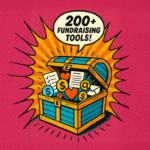Imagine this: a nonprofit arts organization that had a sign outside their venue saying: “Wheelchair users not welcome.”
That would be reprehensible.
And in many places, illegal.
An organization that would do that would clearly have its basic values twisted and broken. I’ve never heard of a nonprofit that would even come close to doing that.
But every day I see nonprofits virtually doing just that by accident. Through lack of knowledge, lack of attention, lack of thinking things through, they are excluding people with different abilities.
It’s both a major ethical lapse and damaging to revenue. Nobody wants that!
Here are some things to think about….
Be sure to design for ease of reading
Some of your donors have lower visual acuity than others. I’m not talking about people who are blind (we’ll look at that in a minute), but simply about people who struggle with seeing clearly.
Because donors are on average older than the general population, low visual acuity is much more common. Probably a large majority of your donors have it to some degree.
To make your materials in print accessible to them, use these design approaches:
Large enough type. Anything you want people to be able to read should be in 13-point type or larger. By all means, don’t go smaller than 12 point – it is literally unreadable to some. The good news is larger type isn’t harder to read for those who have no trouble with small type. In fact, it’s easier. Larger type is better for all readers.
Readable fonts. Some designers just love stylish fonts with very thin strokes, no serifs, and unusual letter forms. They look sleek and modern. But they are hard to read. Impossible for some. Generally, you should be using standard serif fonts in print and sans-serif fonts for screens.
Type contrast. Have maximum contrast between text and its background. That means don’t put type over tints, and don’t use any color but black for type.
No reverse type. Never place white or light-colored type over a dark background. It’s nearly unreadable. Especially don’t put type over photos. It might look cool, but it’s incredibly discriminatory.
In addition to these four design approaches, also use plenty of white space around type, indented paragraphs, and break up long stretches of type with subheads and other things that create differences.
Workable for screen readers
For digital content, such as web pages and PDFs, some people rely on screen readers that audibly read the text. This technology has become quite good. It is used not only by those with low vision, but also some with reading and/or attention issues.
Making content work with screen readers requires following some back-end programming. It’s usually not difficult for designers to do, but often with PDFs that were designed only with their use as printed pieces in mind, it’s completely unusable for screen readers: They may not read it in order or do things like read all the headlines, then all the subheads, then the text.
Getting this right is quite technical and takes knowledge and training.
But if you welcome all readers, it’s necessary.
Ease of comprehension
Writing so your material is easy to read is one of the most important ways to be inclusive of all donors. Reading issues like dyslexia are quite common, and easy-to-read writing really helps. What fundraisers should be doing to produce accessible writing is mainly two things:
Write with good reading ease scores. There are two standard ways to measure reading ease:
- Flesch–Kincaid Grade Level, where a lower number is easier to read. Fundraising should be at or below a 6.
- Flesch Reading Ease score, where a higher number is easier to read. Fundraising should be above 80.
Avoid technical jargon and other complex vocabulary. All professionals have their own vocabulary. Technical, scientific, and academic professions have extremely complex ways of talking.
Using your professional language within your profession may be normal, but fundraising is not an in-house conversation. Most of your donors don’t speak that language. And it could be argued that in-profession language exists to exclude outsiders. Including your donors.
If you want to include everyone in the conversation and give everyone the same opportunity to change the world, you absolutely must use plain and non-technical language.
Titles in videos
This has become easy. Most social media sites, YouTube, and other video hosting services will automatically insert machine-generated text of what is being said on your video. In a variety of languages. The quality of this is getting uncannily good, so you may be able to skip the step of copy-editing the titles.
Here’s the good news: When you make your fundraising accessible for those who need help, you make it better for everyone. It’s not a painful compromise to be inclusive!
You and your donors will benefit.
Explore and master the best practices of inclusive fundraising. Join The Fundraisingology Lab by Moceanic to become part of a supportive community that can show you their challenges and victories. You’ll also get loads of fundraising courses, access to the experts, and more that will take you to new places in your fundraising career. Join the waiting list now and you’ll be the first to hear when the doors open again!
Related Blog Posts:










